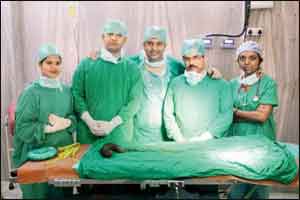- Home
- Editorial
- News
- Practice Guidelines
- Anesthesiology Guidelines
- Cancer Guidelines
- Cardiac Sciences Guidelines
- Critical Care Guidelines
- Dentistry Guidelines
- Dermatology Guidelines
- Diabetes and Endo Guidelines
- Diagnostics Guidelines
- ENT Guidelines
- Featured Practice Guidelines
- Gastroenterology Guidelines
- Geriatrics Guidelines
- Medicine Guidelines
- Nephrology Guidelines
- Neurosciences Guidelines
- Obs and Gynae Guidelines
- Ophthalmology Guidelines
- Orthopaedics Guidelines
- Paediatrics Guidelines
- Psychiatry Guidelines
- Pulmonology Guidelines
- Radiology Guidelines
- Surgery Guidelines
- Urology Guidelines
Mumbai Doctors remove massive lump of Hair from stomach of patient

Doctors at Rajwadi hospital in Ghatkopar in Mumbai remove around 750 g of hair from a 20-year-old girl's stomach who used to eat her own hair.
As per reports, she was suffering from a rare condition known as the Rapunzel Syndrome, which has only been documented 88 times in medical literature the world over.
The girl reported to the hospital with complaints of anorexia ,nausea,loss of weight and swelling of abdomen. A CT scan was requisitioned and the reporting doctor inferred that she was suffering from rare Rapunzel Syndrome.He spotted , a 103 cm long tail of hair in stomach extending till small intestines.On the basis of finding , the doctors concluded that the girl must have been eating her hair for years, a medical condition known as Trichophagia. It is associated with a psychiatric disorder trichotillomania in which patient compulsively pulls out hair due to irresistible urge and eats it. The hair primarily are composed of indigestible proteins which cannot be passed with stools and therefore get deposited in stomach and intestines.
Dr. Bharat Kamath, an assistant professor in the department of surgery at Rajawadi Hospital, who led the surgical team, said, "It had filled her stomach, due to which the patient was unable to eat. Moreover, a tail of hair trailed into her intestine, which is typical in a case of Rapunzel Syndrome," said Dr. Bharat told MID DAY.
The hairball was 25 cm long and about 10-12 cm across. Due to this, doctors believed that she had been eating her hairs for years. This irresistible eating of hair is called Trichophagia. Hair protein does not get digested, nor can the body pass it in a stool.
Rapunzel Syndrome is an extremely rare condition wherein a patient suffering from it gets addicted to ingesting his hair causing formation of a a solid mass of indigestible material in the digestive tract. This formation of a hairball is medically referred to as a trichobezoar and the syndrome is named after Rapunzel ,a long-haired princess from the fairy tale.
Usually the body of this hairball is located in the stomach, and its tail in the small bowel and/or in the right colon.If left untrated it may lead to a fatal condition of small or large bowel obstruction.This hair ball has to be e surgically removed as human hair cannot be digested in the human gastrointestinal tract.In all such cases the patients usually requires psychiatric evaluation and treatment to take care of impulse control disorder, trichotillomania.

Disclaimer: This site is primarily intended for healthcare professionals. Any content/information on this website does not replace the advice of medical and/or health professionals and should not be construed as medical/diagnostic advice/endorsement or prescription. Use of this site is subject to our terms of use, privacy policy, advertisement policy. © 2020 Minerva Medical Treatment Pvt Ltd